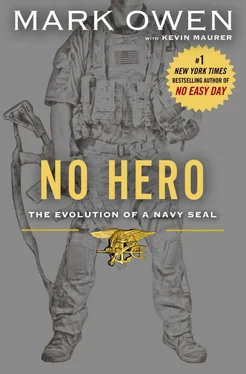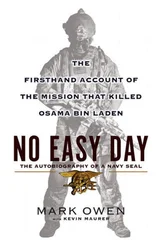CHAPTER 5
Safe Return Doubtful
Mind-set
I slidmy rifle behind me and started to climb up the metal ladder. I could hear it scrape against the side of the building as I reached for the next rung.
Ahead of me, my teammate had already reached the roof and slid over the small parapet wall. I reached the roof seconds later and climbed over, dragging more than sixty pounds of body armor and gear with me. Below, I could see my teammates slowly moving into position at the front door of the target.
We were the “roof team,” which meant we provided overwatch from the high ground. We were about to hit an insurgent safe house, and it was my team’s job to get to the roof to cover the assault. If we were able to enter the building from the roof, we assaulted down the stairs while the ground element assaulted up the stairs. Theoretically, we would capture the bad guys in the middle and hopefully before they had time to resist.
It was 2006 and Iraq was the big priority. The Army unit assigned had taken some heavy casualties and needed replacements. I was only about a month into my first deployment with my own unit when my six-man team was sent from Afghanistan over to Iraq to help. At first, we thought our entire team would be attached as a unit, but when we arrived we got separated and sent individually to different teams.
We flew into the military side of Baghdad International Airport and drove to the Green Zone, a walled-off area of the Iraqi capital occupied by Coalition forces. I’d been to Iraq with SEAL Team Five, so everything looked familiar. Toward the end of that deployment, I’d operated in Baghdad. At that time, we were all new, with little to no combat experience. But landing in Baghdad this time, it felt different. There was energy in the air, a confidence that pervaded the entire military because of our collective combat experience.
I was still pretty new to my team, and I’d never worked with the Army but had heard rumblings about how the two services did not get along. There was always this competition between the two, probably driven by our shared quest to be the best. There were shooting competitions and other drills that always seemed to pit the two units against each other. In my mind, I expected to see or experience this tension, but it never came. All the old-school drama over which unit was better had faded since the war started. We were one team. The team opened up, pulled me in, and made me one of their own. No one cared about which unit shot better when we were all working together fighting a common enemy.
When I landed, Jon, my new team leader, met me at the operations center and took me to my room. He also showed me the chow hall and gym and introduced me to my other teammates. My new team seemed to be made up of guys very much like the SEALs on my old team. We used all the same gear, tactics, and command structure. They were Army, and I was Navy, and there were some cultural differences, but the basic makeup of the guys was very familiar.
Jon welcomed me and included me in all the planning. There was never a moment when I didn’t feel like I was part of the team, but more importantly I felt like Jon and the others were open to hearing my opinion.
Once, we were planning a mission a few weeks after I arrived. My team was slated to land on the roof of the target on an MH-6 Little Bird and clear down from the roof. Jon was working on the manifest, the list of guys going on the mission.
“Space is tight on this one, boys,” Jon said.
He was crunching the numbers to make sure we stayed under the weight limit. I was sure I’d be cut from the mission. I was the new guy and the SEAL. The planning was over and the rest of my team left the operations center. I got my notebook and headed back to the room.
“Hey,” Jon said as I started to leave. “You’re on tonight.”
Later, I saw Jon talking to the other new guy on the team. He was staying behind. The next time we exceeded the weight limit, I stayed behind. Jon always made it a point to swap me out with his other new guy, ensuring I got as much love as the rest of his team. Yes, I was still considered a new guy both at my unit and the Army team, but it was nice to know that Jon thought of me as part of his team.
After the first few missions, I folded myself into the team, and soon I was no longer looked at as the token SEAL replacement. I was just a teammate, one of two new guys on the team.
I’d just met these guys, but I already trusted them with my life and they did the same. I knew that they would risk their lives to save mine and I’d do the same for them. I credit Jon with making the transition seamless. He was one of the best leaders I’ve ever worked for in the military. He didn’t have the respect of his team and others just because he was the boss. He earned everyone’s respect because of his character, his leadership, and his calm demeanor in combat. It seemed like nothing fazed him. I immediately looked up to him as someone I wanted to emulate.
I realized over the course of my career that every special operations unit shared a common mind-set. We were all wired the same way. We all started with a shared sense of purpose. In the past, and in peacetime, there was a rivalry between the units. But once the shooting started, that rivalry was discarded in favor of teamwork, because if there was one thing we all agreed on, it was completing our mission and coming home safe.
If you think of a special operations team—SEALs, Special Forces, Rangers, and the Air Force Pararescuemen and combat controllers—like a boat, everybody rows. The officers down to the newest guy are trained to care about the team first and do what it takes to accomplish the mission. I saw the same mentality when I worked with the international special operations units.
Every single unit I’ve ever worked or trained with had that in common. Some of the gear and tactics might be a bit different. Some of the units had better toys, but in the end it didn’t matter if you had the most expensive rifle or had special training. We all volunteered for the hardest training we could find in our respective countries. We all learned to push ourselves to go well beyond our mental and physical limits.
Units like SEALs and other special operations units have been in existence since war was created. The Greeks had special units and George Washington’s army used sharpshooters during the American Revolution.
But only after World War II did officials start figuring out how best to screen and train special operations forces. And the first step was always finding guys with the right mind-set to achieve the group’s common goal. Mind-set is the common denominator.
Charlie Beckwith, after arriving in Vietnam in 1965, was given command of Project Delta—Detachment B-52. The reconnaissance unit was created to collect intelligence along the Ho Chi Minh Trail and in South Vietnam. Beckwith fired most of the soldiers in the unit when he took command and started to recruit replacements using a flyer.
WANTED: Volunteers for project Delta. Will guarantee you a medal, a body bag, or both. Requirements: have to be a volunteer. Had to be in country for at least six months. Had to have a CIB (Combat Infantry Badge). Had to be at least the rank of Sergeant—otherwise don’t even come and talk to me.
He wanted to find guys like my teammates, who possessed a never-quit attitude and a single-minded drive to accomplish the mission. Starting with the mentality from the flyer, Beckwith later created based on what he learned from the British SAS.
But the military is not the only example. Ernest Shackleton, who led three British expeditions to the Antarctic in the 1900s, reportedly placed an ad in a London newspaper looking for the same type of man:
Читать дальше










